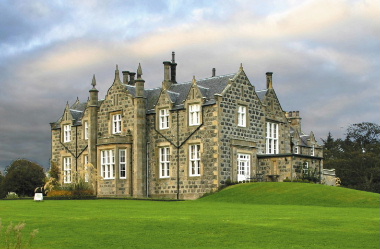
Parish land of Menie passed between
various merchants and landholders, particularly during the 17th
century. David Carnegie sold the lands of Menie to William Forbes
or 'Danzig Willie', who had earned his money through successful
trade exploits in the Baltic. Danzig Willie was still known as
Forbes of Menie in 1617 even after the completion of his more
famous castle at Craigievar. The claim that Forbes sold Menie
to George Gordon of Gight is confirmed by the royal grant of James
VI in July 1618. Menie then seems to have gone through a rapid
turnover of landowners. That John Seton, Chamberlain of Fyvie, was
in possesion in 1622 is confirmed by the funeral account of the
Earl of Dunfermline, Chancellor Seton, in 1622, though it is
presumed that he traded Menie for the larger residence of
Aquhorthies shortly thereafter. Patrick Gordon of Nethermuir obtained a
special warrant from George Gordon for Menie, including the mill,
Leyton, Cothill, Cowhill and Alterseat, in 1623. Another source
notes that in 1623 the half lands of Mains of Menie and the half
lands of Hatterseat were renounced to George Gordon of Gight by
the wife of the baillie and burgess of Aberdeen, Agnes Johnestoun.
Six years later Gordon sold the lands and barony of Menie to
William Seton of Udny. Seton held them until his creditor, Robert
Graham of Morphie, was granted them in 1633. In 1659 Menie,
Legtane, Cothill, Cowhill and Alterseat were mortgaged to Robert
Kerr, burgess of Aberdeen, who held them in 'free blench farm' for
the annual sum of one Scots penny. Mr John Reid of Birnes held a
special warrandice of the lands of Menie in 1664. Robert Kerr
passed them on to his brother Alexander in 1678. Alexander’s
grandson, also named Alexander, certainly held the lands until
1696 when he was noted in the Poll Book, before they reverted to
the Setons. James Seton, of the
family of Meldrum, then became the 3rd Seton Laird of Menie.
From royalty and government bodies
to authors and painters, Belhelvie parish has had a significant
role to play in the history of both Scotland and the British Isles
during the last millennium. It is far more than a small rugged
portion of the northeast landscape of Scotland. There are
connections with the earliest establishment of Christianity in
Scotland, with the Vatican, and with Norwegian royalty, and had
its fair share of domestic upheavals over the centuries: treason,
witch-trials, famine, and the politically turbulent times of
Covenanting and Jacobite Scotland.